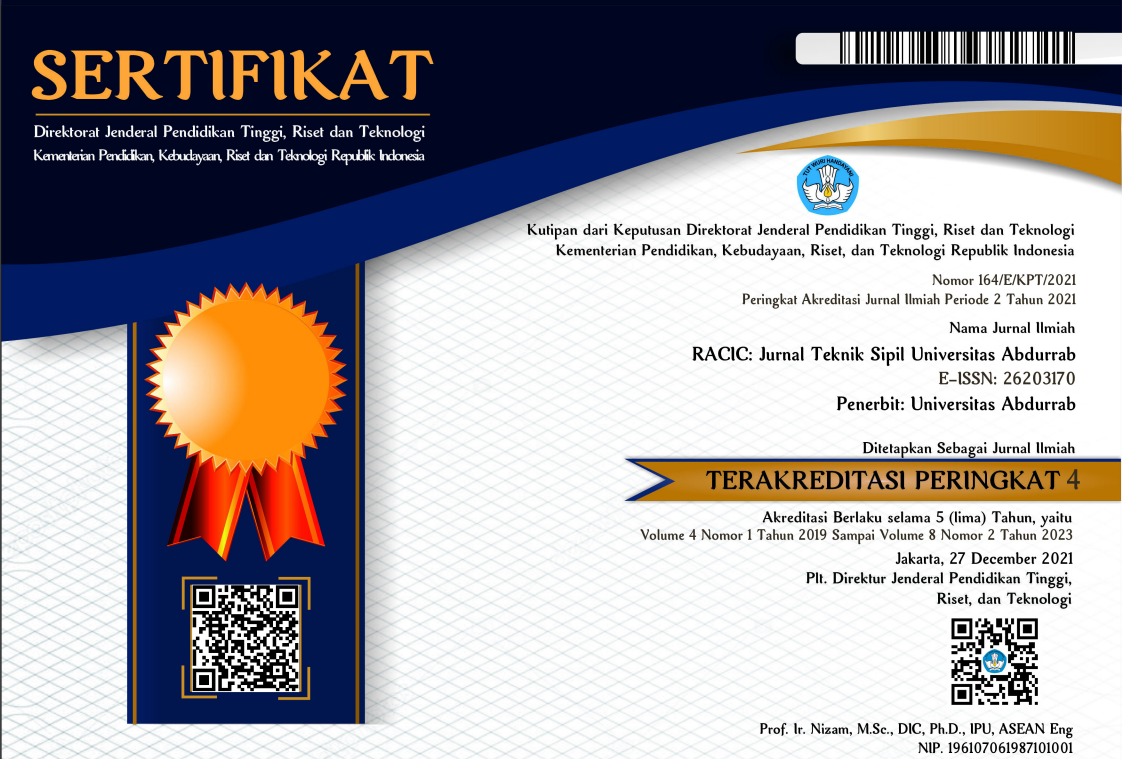ANALISIS KOMPARASI PERHITUNGAN VOLUME PEKERJAAN STRUKTUR BERDASARKAN METODE SPMI DAN BIM
DOI:
https://doi.org/10.36341/racic.v7i1.2400Keywords:
Volume, BQ (Bill of Quantity), SMPI (Standar Metode Perhitungan Indonesia), BIM (Building Information Modeling), Autodesk RevitAbstract
QTO (Quantity Take Off) is a measurement for calculating the volume of the entire building in detail. QTO calculation has 2 (two) methods, namely the manual calculation method using the SMPI (Standard Metode Pengukuran Indonesia) and the digital calculation method using BIM (Building Information Modeling). The BIM that used in the calculation of this research is Autodesk Revit. Both methods have their respective advantages, disadvantages, and have the potential to produce different volume calculation results. Therefore, both methods are used in this research and the results has been compared. The results of the total volume be written into a construction document called the BQ (Bill of Quantity). BQ generate calculations from both BIM (Revit) and manual calculations (SMPI). Difference in calculation results between manual calculation (SMPI) and BIM (Revit) calculation for rebar is 0,49%; concrete is 0,14%; while formwork is 0,07%. This indicates that the manual calculation method and the BIM calculation method (Revit) provide approximately same and accurate results. The largest difference in volume calculation results is found in the calculation of rebar due to inaccuracies of 3D modeling carried out by engineers. 3D modeling on Revit software requires special skill for precision, accuracy, and expertise, as the potential for 3D modeling errors is very high.
Downloads
References
Olsen, D., & Taylor, J. M. (2017). Quantity Take-Off Using Building Information Modeling (BIM), and Its Limiting Factors . Creative Construction Conference 2017 (pp. 1098 – 1105 ). Primošten, Croatia: Procedia Engineering 196.
Khosakitchalert, C., Yabuki, N., & Fukuda, T. (2019). Improving the accuracy of BIM-based quantity takeoff for compound. Automation in Construction 106, 1-20.
Utama, W. P., Peli, M., & Jumas, D. Y. (2008). Standardisasi Pengukuran Kuantitas Pekerjaan Konstruksi di Indonesia: Suatu Gagasan. Prosiding PPIS Bandung. Bandung.
Towey, D. (2013). Cost Management of Construction Projects. United Kingdom: Willey Blackwell.
Monteiro, A., & Martins, J. P. (2013). A survey on modeling guidelines for quantity takeoff-oriented BIM-based design. Automation in Construction, 238-253.
Berlian, C. A., Adhi, R. A., Hidayat, A., & Nugroho, H. (2016). Perbandingan efisiensi waktu, biaya, dan sumber daya manusia antara metode Building Information Modeling (BIM) dan konvensional. Jurnal Karya Teknik Sipil, 220-229.
Hardin, B. (2009). BIM and Construction Management. Indianapolis: Wiley Publishing, IN.
Azhar, S., Khalfan, M., & Maqsood, T. (2012). Building Information Modeling (BIM): Now and Beyond . Australasian Journal of Construction Economics and Building, 15-28.
Peurifoy, R., & Oberlender, G. (2013). Estimating Construction Costs. Boston: McGraw Hill.
Downloads
Published
Issue
Section
License
1. Copyright of all journal manuscripts is held by the RACIC : Rab Construction Research
2. Formal legal provisions to access digital articles of electronic journal are subject to the provision of the Creative Commons Attribution-ShareAlike license (CC BY-NC-SA), which means that RACIC : Rab Construction Research is rightful to keep, transfer media/format, manage in the form of databases, maintain, and publish articles.
3. Published manuscripts both printed and electronic are open access for educational, research, and library purposes. Additionally, the editorial board is not responsible for any violations of copyright law.
licensed under a Creative Commons Attribution-ShareAlike 4.0 International License.





